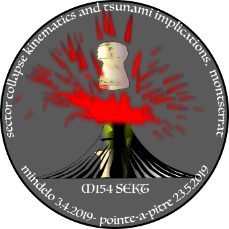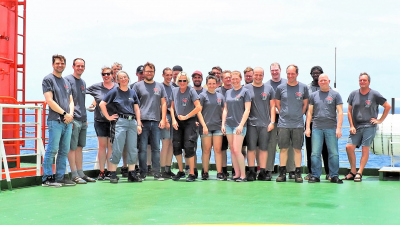- Home
- Research
- Expeditions
- 2019
- M154-2
M154-2
Sector collapse kinematics and tsunami implications – SEKT
Deep-seated collapses of volcanic islands have generated the largest volume mass flows worldwide. These mass flows might trigger mega-tsunamis. The way in which these collapse events are emplaced is poorly understood, even though this emplacement process determines the scale of associated tsunamis.
Key questions such as (1) whether they are emplaced in single or multiple events, (2) how they may incorporate seafloor sediment to increase their volume, and(3) how they are related to volcanic eruption cycles and migration of volcanic centers, still remain to be answered.
This project will form a part of the comprehensive study of large volcanic island landslide deposits and is directly linked to IODP drilling campaign in the Lesser Antilles (IODP Leg 340). Unfortunately, Leg 340 only recovered material from a single site within the volcanic landslide deposits off Montserrat, and even at this site recovery was not continuous. This single IODP site is insufficient to document lateral variation in landslide character, which is critical for understanding how it was emplaced.
Combining 3D seismology (M154-1 Leg 1) and MeBo cores (M154-2 Leg 2) will provide a unique dataset of the internal structure, composition and source of material throughout a volcanic island landslide. The results will significantly contribute to understanding the emplacement of volcanic island landslides and they will allow us to assess the associated tsunami risk. The main scientific goals of this project areto determine where the landslides are sourced from; to understand how these landslides are emplaced; and to understand the relationship between landslides, eruption cycles and initiation of new volcanic centres.

Chief Scientist
|
Phone: |
|
|
Fax: |
+49 421 218-65872 |
|
Email: |
|
|
Room: |
MARUM II, 3040 |
Scientific Programme M154-2
The overarching aim of this project is to provide sediment and rock samples of the slid masses of different submarine landslide events offshore Montserrat.
The expedition M154-2 aims to carry out systematic drilling transects using the Bremen sea floor drill rig MeBo70 within the area of the slid masses and the adjacent undeformed slope.
The MeBo drill rig is capable of coring up to 70m of subsurface section. This coring operation will be paired with dense seafloor sediment sampling using classical gravity coring and grab sampling. Core materials will enable to gain a deeper insight into sediment composition as well as their geotechnical characterization. These information about sediment-physical behavior of both deformed and undeformed sediments are essential to test a number of hypotheses regarding their Tsunami potential. The emplacement dynamics of these landslides and their relationship to volcanic eruption cycles or magmatic evolution are poorly understood at present, due to a lack of detailed studies of landslide deposits. Furthermore, these data shed light on the relationship between submarine slope failure processes and volcanic activity.
The coring operations will be paired with heat-flow measurements.

Weekly reports


